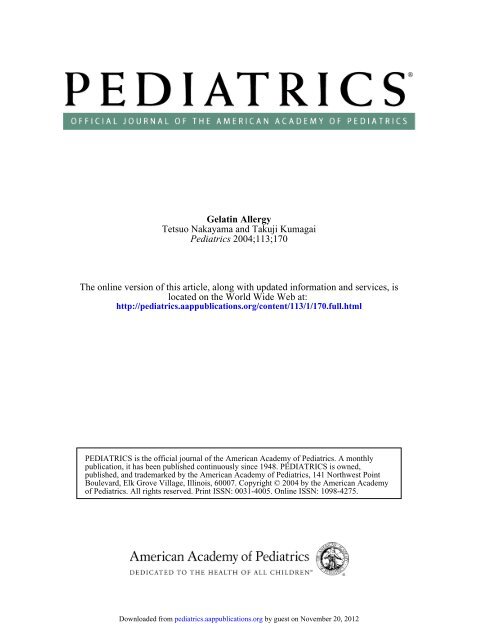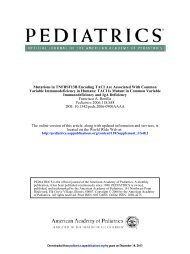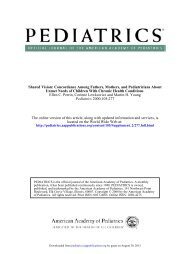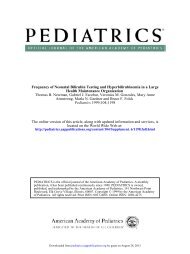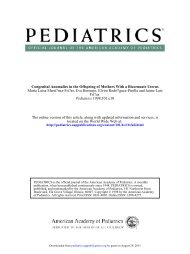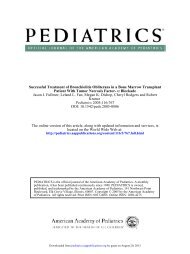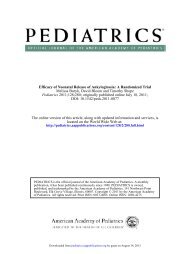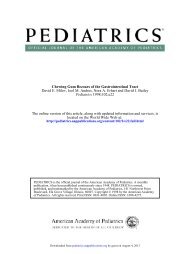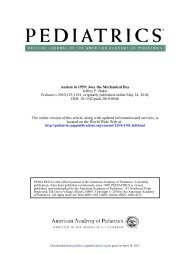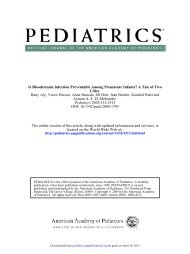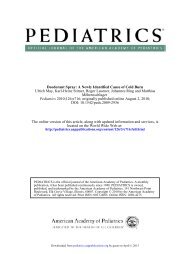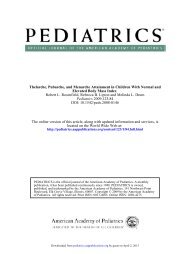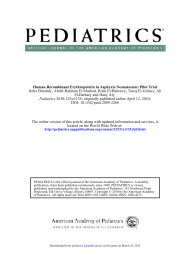Gelatin Allergy - Pediatrics
Gelatin Allergy - Pediatrics
Gelatin Allergy - Pediatrics
Create successful ePaper yourself
Turn your PDF publications into a flip-book with our unique Google optimized e-Paper software.
<strong>Gelatin</strong> <strong>Allergy</strong><br />
Tetsuo Nakayama and Takuji Kumagai<br />
<strong>Pediatrics</strong> 2004;113;170<br />
The online version of this article, along with updated information and services, is<br />
located on the World Wide Web at:<br />
http://pediatrics.aappublications.org/content/113/1/170.full.html<br />
PEDIATRICS is the official journal of the American Academy of <strong>Pediatrics</strong>. A monthly<br />
publication, it has been published continuously since 1948. PEDIATRICS is owned,<br />
published, and trademarked by the American Academy of <strong>Pediatrics</strong>, 141 Northwest Point<br />
Boulevard, Elk Grove Village, Illinois, 60007. Copyright © 2004 by the American Academy<br />
of <strong>Pediatrics</strong>. All rights reserved. Print ISSN: 0031-4005. Online ISSN: 1098-4275.<br />
Downloaded from<br />
pediatrics.aappublications.org by guest on November 20, 2012
not need additional oxygen on the day of observation. One would<br />
expect much lower mean Spo 2 values in infants with cyanotic<br />
heart failure. 7 Also, Lou’s 8 study on attention-deficit hyperactivity<br />
disorder describes infants with recurrent episodes of hypoxemia.<br />
Using the definition of hypoxemia given by Poets 4,9 (i.e. oxygen<br />
saturation �80% for at least 4 seconds), none of our infants suffered<br />
from hypoxemia while being carried in the sling. Tin et al 10<br />
pointed out in their study that the saturation level in preterm<br />
infants is of only little influence on neurological outcome and on<br />
the development of retinopathy. Their study showed that the<br />
development of cerebral palsy in 296 preterm infants �28 gestational<br />
weeks did not correlate with the saturation level (target<br />
saturation level between minimum 70%–90% and maximum 88%–<br />
98%). Moreover, the percentage of threshold retinopathy in 1-year<br />
survivors increased with the saturation level.<br />
As mentioned in our article, we only observed desaturation<br />
episodes (�88%) in preterm babies. We advised caution with the<br />
use of slings for carrying preterm infants before they reach term<br />
postconceptional age, although no desaturation below 80% was<br />
seen in our study, and the clinical relevance of desaturation to<br />
Spo 2 levels between 88% and 80% is unclear. We remain satisfied<br />
with our conclusion that term babies are not at risk of desaturation<br />
while being carried in the sling.<br />
REFERENCES<br />
Waltraud Stening, MD<br />
Patrizia Nitsch<br />
Bernhard Roth, MD<br />
Department of Neonatology<br />
Children’s Hospital<br />
University of Cologne<br />
D-50924 Koeln, Germany<br />
1. Stening W, Nitsch P, Wassmer G, Roth B. Cardiorespiratory stability of<br />
premature and term infants carried in infant slings. <strong>Pediatrics</strong>. 2002;110:<br />
879–883<br />
2. Bass JL, Mehta KA, Camara J. Monitoring premature infants in car seats:<br />
implementing the American Academy of <strong>Pediatrics</strong> policy in a community<br />
hospital. <strong>Pediatrics</strong>. 1993;91:1137–1141<br />
3. Merchant JR, Worwa C, Porter S, Coleman JM, DeRegnier RAO. Respiratory<br />
instability of term and near-term healthy newborn infants in car<br />
safety seats. <strong>Pediatrics</strong>. 2001;108:647–652<br />
4. Poets CF. When do infants need additional oxygen? A review of current<br />
literature. Pediatr Pulmonol. 1998;26:424–428<br />
5. Poets CF, Stebbens VA, Lang JA, O’Brian LM, Boon AW, Southall DP.<br />
Arterial oxygen saturation in healthy term neonates. Eur J Pediatr.<br />
1996;155:219–223<br />
6. Poets CF, Stebbens VA, Alexander JR, Arrowsmith WA, Salfield SAW,<br />
Southall DP. Arterial oxygen saturation in preterm infants at discharge<br />
from hospital and six weeks later. J Pediatr. 1992;120:447–454<br />
7. Newburger JW, Silbert AR, Buckley LP, Fyler DC. Cognitive function<br />
and age of repair of transposition of the great arteries in children. N Engl<br />
J Med. 1984;310:1495–1499<br />
8. Lou HC. Etiology and pathogenesis of attention-deficit hyperactivity<br />
disorder (ADHD): significance of prematurity and perinatal hypoxichaemodynamic<br />
encephalopathy. Acta Paediatr. 1996;85:1266–1271<br />
9. Poets CF, Stebbens VA, Samuel MP, Southall DP. The relationship<br />
between bradycardia, apnea and hypoxemia in preterm infants. Pediatr<br />
Res. 1993;34:144–147<br />
10. Tin W, Sinha S, Milligan D. Oxygen saturation measured by pulse<br />
oximetry and its relation to “threshold” retinopathy and outcome at one<br />
year in babies of less than 28 weeks gestation. Pediatr Res. 1999;(suppl<br />
1):229 A<br />
<strong>Gelatin</strong> <strong>Allergy</strong><br />
To the Editor.—<br />
We feel relieved after reading the paper by Pool et al and the<br />
VAERS Team1 on the prevalence of gelatin allergy in the United<br />
States. They conducted a retrospective analysis after measlesmumps-rubella<br />
(MMR) vaccination. Among 26 cases of anaphylaxis,<br />
only 6 (27%) were positive for anti-gelatin IgE antibodies.<br />
The rate of anaphylactic reactions reported to the VAERS is 1.8 per<br />
1 million doses, and no substantial increase in number of reported<br />
allergic events after MMR was observed since the introduction of<br />
gelatin-containing diptheria-tetanus-acellular pertussis vaccine<br />
(DTaP) in 1997. We reported that the cases of anaphylaxis or<br />
urticaria showed high positive rates of anti-gelatin IgE antibodies,<br />
and we speculated the causal relationship of the sensitization by<br />
gelatin-containing DTaP. 2 Discontinuation of gelatin-containing<br />
DTaP reduced the incidence of anaphylaxis after 1999, 3 and we<br />
have no report of anaphylaxis after vaccination with live virus<br />
vaccines containing hydrolyzed porcine gelatin in the last few<br />
years. Thus, we were solicitous for the incidence of anaphylaxis in<br />
the United States, but they reported that the incidence of gelatin<br />
allergy was lower than that observed in Japan.<br />
But we suppose the different prevalence of anti-gelatin IgE<br />
depends on sensitivity for the detection of IgE antibodies against<br />
gelatin and especially on the nature of antigen for the assay. The<br />
same was the reason why the sensitization against gelatin increased<br />
in Japan. Some vaccine manufactures used poorly hydrolyzed<br />
bovine gelatin in DTaP, and some used hydrolyzed porcine<br />
gelatin. A large number of patients with anaphylaxis had a history<br />
of having DTaP containing poorly hydrolyzed bovine gelatin.<br />
Poorly hydrolyzed bovine gelatin was immunogenic when administered<br />
with alum adjuvant. They did not mention the nature of<br />
gelatin in DTaP in the United States in their paper, and we<br />
suppose that it was probably highly hydrolyzed porcine gelatin<br />
(2–3 kDa). Although it is considered as less immunogenic, gelatinfree<br />
DTaP is desirable to avoid the possibility of unnecessary<br />
sensitization against gelatin.<br />
Tetsuo Nakayama, MD<br />
Laboratory of Viral Infection Control<br />
Kitasato Institutes for Life Sciences<br />
Tokyo 108-8641, Japan<br />
Takuji Kumagai, MD<br />
Pediatric <strong>Allergy</strong> and Infectious Diseases<br />
Society of Sapporo<br />
Sapporo 004-0013, Japan<br />
REFERENCES<br />
1. Pool V, Braun MM, Kelso JM, et al. Prevalence of anti-gelatin Ig E<br />
antibodies in people with anaphylaxis after measles-mumps-rubella<br />
vaccine in the United States. <strong>Pediatrics</strong>. 2002;110(6). Available at: http://<br />
www.pediatrics.org/cgi/content/full/110/6/e71<br />
2. Nakayama T, Aizawa C, Kuno-Sakai H. A clinical analysis of gelatin<br />
allergy and determination of its causal relationship to the previous<br />
administration of gelatin-containing acellular pertussis vaccine combined<br />
with diphtheria and tetanus toxoids. J <strong>Allergy</strong> Clin Immunol.<br />
1999;103:321–325<br />
3. Nakayama T, Aizawa C. Change in gelatin content of vaccines associated<br />
with reduction in reports of allergic reactions. J <strong>Allergy</strong> Clin Immunol.<br />
2000;106:591–592<br />
In Reply.—<br />
Drs Nakayama and Kumagai note the difference in the prevalence<br />
of anti-gelatin IgE antibodies found in sera from patients<br />
suffering anaphylactic reactions to measles-mumps-rubella<br />
(MMR) vaccines in their study in Japan (93%) 1 and our study in<br />
the United States (27%). 2 They suggest that this difference may be<br />
due to differences in the sensitivity and specificity of tests to detect<br />
anti-gelatin IgE, which in turn may depend on the nature of<br />
gelatin used in the assay. The solid-phase allergen for the radioimmunoassay<br />
we used was made from a random lot of flavored<br />
sugared commercial gelatin (Jell-O) and thus not exactly the same<br />
gelatin that is present in MMR vaccines. It is not clear if the<br />
“bovine gelatin” used in their assay was the same as that used in<br />
vaccines manufactured in Japan. However, we believe that differences<br />
between the gelatin in the immunoassay and the gelatin in<br />
the vaccine are unlikely to be the primary explanation for the<br />
difference in prevalence of anti-gelatin IgE found in the Japanese<br />
and US studies. In the first case report describing gelatin allergy as<br />
a cause of anaphylaxis to MMR, inhibition immunoassays were<br />
performed. 3 The patient’s anti-gelatin IgE antibodies directed<br />
against gelatin (the same type of gelatin used in the assay in our<br />
present study) were inhibited not only by both bovine and porcine<br />
laboratory gelatins but also by the MMR vaccine itself containing<br />
170 LETTERS TO THE EDITOR<br />
Downloaded from<br />
pediatrics.aappublications.org by guest on November 20, 2012
pharmaceutical gelatin. This suggests that common IgE-binding<br />
gelatin epitopes are present on a wide variety of animal gelatins<br />
regardless of source or use. We also note that the prevalence of<br />
anti-gelatin IgE we found in US recipients of MMR suffering<br />
anaphylaxis (27%) is remarkably similar to that found in a study<br />
from Finland (28%) using different immunoassay techniques. 4 We<br />
believe a possibly more likely explanation for the difference in<br />
Japanese and US prevalence has been proposed by Dr Kumagai<br />
himself in a report describing a strong association between gelatin<br />
allergy and HLA-DR9, which is unique to Asians, in which he<br />
concludes that this association would “seem to provide a key<br />
answer to the question why there are so many reports of gelatin<br />
allergy in Japan compared to other countries.” 5<br />
Drs Nakayama and Kumagai note that the addition of poorly<br />
hydrolyzed gelatin to diphtheria-tetanus-acellular pertussis (DTaP)<br />
vaccines in Japan may have contributed to sensitization to gelatin<br />
in some children, resulting in increased risk of anaphylaxis on<br />
subsequent MMR vaccination. 1 Removal of the gelatin from DTaP<br />
vaccines in Japan was followed by a decline in reports of anaphylaxis<br />
to subsequently administered MMR vaccines. 6 However, the<br />
nature of the gelatin in the MMR vaccine was also changed to a<br />
more thoroughly hydrolyzed material at the same time. Either or<br />
both of these changes could have contributed to the decline in<br />
reactions. 6 We do not believe that gelatin containing DTaP is a<br />
likely contributor to reactions to MMR in the United States, however.<br />
During a time when DTaP vaccines that contained traces of<br />
hydrolyzed gelatin became widely used, we did not observe an<br />
increase in allergic reactions to subsequently administered gelatincontaining<br />
MMR or varicella vaccines. 2<br />
Certainly we share with Drs Nakayama and Kumagai the conclusion<br />
that gelatin is responsible for a noticeable proportion of<br />
anaphylactic reactions to gelatin-containing vaccines, although the<br />
rates may differ in different countries (as discussed above).<br />
Persons with a history of anaphylaxis after MMR or other<br />
gelatin-containing vaccine are likely at increased risk of similar<br />
reactions to subsequent doses of other gelatin-containing vaccines<br />
such as varicella and some brands of influenza. Therefore, for<br />
these persons we continue to recommend an allergy evaluation<br />
including assessment of anti-gelatin IgE by skin testing or now<br />
commercially available in vitro testing prior to such immunization.<br />
Vitali Pool, MD*<br />
Gina Mootrey, DO, MPH*<br />
Robert T. Chen, MD, MA*<br />
Paul M. Gargiullo, PhD‡<br />
*Immunization Safety Branch<br />
‡Viral Vaccine Preventable Diseases Branch<br />
Epidemiology and Surveillance Division<br />
National Immunization Program<br />
Centers for Disease Control and Prevention<br />
Atlanta, GA 30333<br />
M. Miles Braun, MD, MPH<br />
Division of Epidemiology<br />
Office of Biostatistics and Epidemiology<br />
Center for Biologics Evaluation and Research<br />
Food and Drug Administration<br />
Rockville, MD 20852<br />
John M. Kelso, MD<br />
<strong>Allergy</strong> Division<br />
Naval Medical Center<br />
San Diego, CA 92134<br />
John W. Yunginger, MD<br />
Robert M. Jacobson, MD*<br />
*Department of Pediatric and Adolescent Medicine<br />
Mayo Clinic College of Medicine<br />
Rochester, MN 55905<br />
REFERENCES<br />
1. Nakayama T, Aizawa C, Kuno-Sakai H. A clinical analysis of gelatin<br />
allergy and determination of its causal relationship to the previous<br />
administration of gelatin-containing acellular pertussis vaccine com-<br />
bined with diphtheria and tetanus toxoids. J <strong>Allergy</strong> Clin Immunol.<br />
1999;103:321–325<br />
2. Pool V, Braun MM, Kelso JM, et al. Prevalence of anti-gelatin IgE<br />
antibodies in people with anaphylaxis after measles-mumps-rubella<br />
vaccine in the United States. <strong>Pediatrics</strong>. 2002;110(6). Available at: http://<br />
www.pediatrics.org/cgi/content/full/110/6/e71<br />
3. Kelso JM, Jones RT, Yunginger JW. Anaphylaxis to measles, mumps,<br />
and rubella vaccine mediated by IgE to gelatin. J <strong>Allergy</strong> Clin Immunol.<br />
1993;91:867–872<br />
4. Patja A, Mäkinen-Kiljunen S, Davidkin I, Paunio M, Peltola H. Allergic<br />
reactions to measles-mumps-rubella vaccination. <strong>Pediatrics</strong>. 2001;107(2).<br />
Available at: http://www.pediatrics.org/cgi/content/full/107/2/e27<br />
5. Kumagai T, Yamanaka T, Wataya Y, et al. A strong association between<br />
HLA-DR9 and gelatin allergy in the Japanese population. Vaccine. 2001;<br />
19:3273–3276<br />
6. Nakayama T, Aizawa C. Change in gelatin content of vaccines associated<br />
with reduction in reports of allergic reactions. J <strong>Allergy</strong> Clin Immunol.<br />
2000;106:591–592<br />
Is Obesity Associated With Early Sexual<br />
Maturation?<br />
To the Editor.—<br />
I read with interest the article by Dr Wang1 and would like to<br />
share with you our experience in a different population, performing<br />
a close follow-up study. 2 We analyzed in detail the auxology<br />
and the appearance and size of pubertal signs compared to weight<br />
and skinfolds in boys and girls with simple obesity between the 10<br />
and 16 years old.<br />
All were Israeli-born Jews referred and followed because of<br />
simple obesity. The group consisted of 136 boys, 41 girls, and 48<br />
age-matched, randomly selected, healthy boys and 48 healthy<br />
girls. Our main statistically significant findings were as follows: At<br />
all ages, the obese boys were taller and their bone age more<br />
advanced than the controls up to age 14 (P � .01 and .001). There<br />
was no difference between the two male groups in the time of<br />
appearance and development of axillary or pubic hair, moustache,<br />
beard, acne or breaking of the voice, testicular volume, and penile<br />
size. The mean overall pubertal score and age of first ejaculation3 were also similar.<br />
The obese girls were taller than the controls up to age 14, with<br />
a statistically significant difference between 11 and 13 (P � .001).<br />
The bone age was significantly advanced between 9 and 11 years<br />
(P � .01), but there was no significant difference in the age of<br />
appearance and development of the breasts, pubic hair, genitalia,<br />
or age at menarche. There were two additional small groups of<br />
obese girls: 8 with obesity and tall stature but without sexual<br />
precocity and 12 obese girls with precocious puberty. The degree<br />
of obesity in these girls was not different from those with so-called<br />
simple obesity, and therefore we concluded that these developmental<br />
characteristics were hereditary.<br />
An additional finding was that parents of the obese children<br />
were significantly overweight (P � .01) compared with the parents<br />
of the controls, supporting the opinion of Schwarz4 that obesity is<br />
a hereditary disorder with familial faulty dietary habits. We concluded<br />
that our data do not support the hypotheses of a “critical<br />
weight factor” determining sexual maturation.<br />
Zvi Laron, MD<br />
Endocrinology and Diabetes Research Unit<br />
Schneider Children’s Medical Center<br />
Tel Aviv University<br />
Petah Tikva 49202, Israel<br />
REFERENCES<br />
1. Wang Y. Is obesity associated with early sexual maturation? A comparison<br />
of the association in American boys versus girls. <strong>Pediatrics</strong>. 2002;<br />
110:903–910<br />
2. Laron Z, Ben-Dan I, Shrem M, et al. Puberty in simple obese boys and<br />
girls. In: Cacciari E, Laron Z, Raiti S, eds. Obesity in Childhood. London,<br />
United Kingdom: Academic Press; 1978:29–40<br />
3. Laron Z, Arad J, Gurewitz R, et al. Age at first conscious ejaculation: A<br />
milestone in male puberty. Helv Paediatr Acta. 1980;35:13–20<br />
4. Schwarz F. Growth and development of obese children. In: van der<br />
LETTERS TO THE EDITOR 171<br />
Downloaded from<br />
pediatrics.aappublications.org by guest on November 20, 2012
Updated Information &<br />
Services<br />
Permissions & Licensing<br />
Reprints<br />
<strong>Gelatin</strong> <strong>Allergy</strong><br />
Tetsuo Nakayama and Takuji Kumagai<br />
<strong>Pediatrics</strong> 2004;113;170<br />
including high resolution figures, can be found at:<br />
http://pediatrics.aappublications.org/content/113/1/170.full.ht<br />
ml<br />
Information about reproducing this article in parts (figures,<br />
tables) or in its entirety can be found online at:<br />
http://pediatrics.aappublications.org/site/misc/Permissions.xht<br />
ml<br />
Information about ordering reprints can be found online:<br />
http://pediatrics.aappublications.org/site/misc/reprints.xhtml<br />
PEDIATRICS is the official journal of the American Academy of <strong>Pediatrics</strong>. A monthly<br />
publication, it has been published continuously since 1948. PEDIATRICS is owned, published,<br />
and trademarked by the American Academy of <strong>Pediatrics</strong>, 141 Northwest Point Boulevard, Elk<br />
Grove Village, Illinois, 60007. Copyright © 2004 by the American Academy of <strong>Pediatrics</strong>. All<br />
rights reserved. Print ISSN: 0031-4005. Online ISSN: 1098-4275.<br />
Downloaded from<br />
pediatrics.aappublications.org by guest on November 20, 2012


